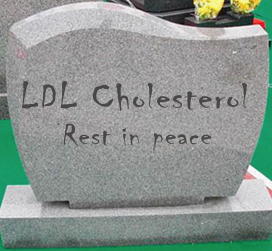In the 1960s, doctors struggled with the concept of cholesterol and its relationship to heart disease. It was becoming clear that higher levels of cholesterol were predictive of heart disease. It was also becoming clear that the low-density fraction of cholesterol, or LDL, was somewhat better than total cholesterol in predicting heart attack.
Cholesterol was easily measurable in the 1960s. LDL was not. So, Dr. Friedewald, a noted lipid researcher at the National Institutes of Health, proposed an easy method to calculate LDL cholesterol from total choleseterol, HDL, and triglycerides:
LDL cholesterol = Total cholesterol – HDL cholesterol – triglycerides/5
This simple manipulation would put LDL cholesterols into the hands of the practicing physician and the American public. Dr. Friedewald recognized that this calculation only represented an approximation of LDL cholesterol and that it was thrown off, sometimes substantially, by any abnormal rise in triglycerides or reduction in HDL. But it served its purpose at an age when most doctors hadn’t even heard of cholesterol and the public was still sold on whole milk and “farm-fresh” butter, and Chesterfields were the cigarette choice of most doctors.
The world has since changed. Most doctors have heard about cholesterol and, along with the public, have been drowned in drug company marketing for cholesterol-reducing drugs. Most people with some level of common sense and health awareness no longer use butter or whole milk, and no longer believe that the brand of cigarette you choose can be healthy. But we’re still using Dr. Friedewald’s original calculation for LDL cholesterol. When you get an LDL cholesterol from your clinic, doctor, or hospital, >99% of the time it is obtained using Dr. Friedewald’s calculation.
Is it because there’s nothing better available? No, it’s not. There’s two reasons why your neighborhood primary care physician or cardiologist is still using this dinosaur of testing called LDL:
1) The lag in science to practice is 20 years. Accept that most primary care doctors are 20 years behind the times on many issues, LDL cholesterol included.
2) Insurance companies vigorously discourage testing beyond conventional lipids. The array of objections we get from insurance companies is mind-boggling. It would be funny if human life and finances weren’t at stake. These “new” tests are “experimental”, “unproven”, not endorsed by standard guidelines, not approved by some internal committee, or simply “We don’t know what this test is” we’ve heard them all.
What are the tests that are superior to Dr. Friendewald’s calculated LDL? There are several, listed here in order of best to worst:
1) LDL particle number--the value generated by NMR lipoprotein testing. This is the gold standard, most reliable test available, and the one I recommend.
2) Apoprotein B--More widely available even from conventional laboratories in hospitals. Not as accurate as NMR LDL particle number, but a pretty good choice. Apo B is the principal protein in LDL, VLDL, and IDL particles, and so it’s a better reflector of risk from all of these lipoprotein fractions, not just LDL.
3) “Direct” LDL--This is LDL that is actually measured. Unfortunately, it ignores the issues of LDL size and has some other pitfalls, but it’s still better than calculated LDL
4) Non-HDL cholesterol--So-called because it incorporates all undesirable cholesterol-containing lipids except good HDL, thus “non-HDL”. This is another calculation, though better than LDL (because it sums up the risk from other apoprotein B-containing lipoproteins). Non-HDL is calculated from Total cholesterol – HDL. It’s therefore available from any standard lipid panel. It’s little used in everyday practice, however, because most people and their physicians find it confusing.
5) Friedewald calculated LDL--You can see that calculated LDL is last on a list of choices. Yet this is the measure that doctors use day in, day out. It’s the measure that drug companies base billions of dollars of revenue and profits on.
It’s an everyday occurrence in my office that calculated LDL is 89 mg/dl, but the real value is somewhere between 160 and 200 mg/dl. That’s a big difference. Imagine your realtor tells you your house’s estimated value is $200,000 and that’s what you sell it for to an eager buyer. After closing, you find out your house was really worth $300,000. You’d be upset. But that’s what you’re often getting with LDL cholesterola bum deal.
It’s part of the reason people will say, “My doctor said my cholesterol was fine and that no cause for my heart disease can be found. He said it was genetic.” In reality, they could have sky-high LDL cholesterol revealed by LDL particle number or apoprotein B.
Use LDL cholesterol in a pinch when you’ve got nothing else. It’s also helpful to gauge any treatment effect of diet, functional foods, drugs, etc. But it is a seriously flawed tool to diagnose your initial level of risk.